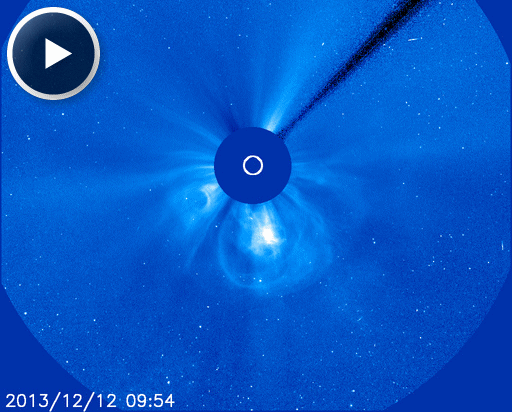METEOR SHOWER PEAKING: The International Meteor Organization is reporting Geminid rates between 100 and 200 per hour (ZHR) on Dec. 14th. This means the shower is peaking. Check the realtime photo gallery for Geminid photos from around the world. And if it's dark where you are, be alert for meteors! [sky map] [meteor radar]
Last night, NASA's network of all-sky meteor cameras detected 67 Geminid fireballs over the United States. One of them flew over the New Mexico observatory of amateur astronomer Thomas Ashcraft. Click to see--and hear--the fireball:
The soundtrack of Ashcraft's fireball movie is the echo of a distant TV transmission bouncing off the ionized trail of the disintegrating meteoroid. "By radio I could tell there was a strong display of meteors all through the night," says Ashcraft. "We were lucky that some Geminid fireballs appeared through holes in our cloudy skies."
INCOMING CMES, CHANCE OF STORMS: Yesterday, December 12th, a pair of magnetic filaments on the sun erupted in quick succession between 0300 UT and 0630 UT. The explosions hurled a pair of coronal mass ejections (CMEs) into space. SOHO recorded the clouds racing away from the sun at approximately 1.1 million mph (500 km/s):
Although neither explosion was squarely Earth-directed, the two clouds could deliver glancing blows to Earth's magnetic field on Dec. 14th or (more likely) the 15th. NOAA forecasters estimate a 40% chance of polar geomagnetic storms when the clouds arrive. Aurora alerts: text, voice
EDGE OF SPACE CHRISTMAS CARDS: What do you give to the sky watcher who has everything? How about a Christmas card from the Edge of Space? For only $49.95, the students of Earth to Sky Calculus will fly your holiday greeting or favorite picture to the top of Earth's atmosphere, photograph it, and return the snapshot in time for the holidays. It's a unique gift! The group has previously flown cupcakes, shoes, US presidents, ad banners and telescopes. This holiday magic is performed using suborbital helium balloons. Contact Dr. Tony Phillips for more information.

Solar wind
speed: 599.9 km/sec
density: 5.8 protons/cm3
explanation | more data
Updated: Today at 2126 UT
X-ray Solar Flares
6-hr max: C1 1537 UT Dec14
24-hr: C2 1124 UT Dec14
explanation | more data
Updated: Today at: 2100 UT
![]()
Daily Sun: 14 Dec 13
Sunspots AR1917 and AR1918 have 'beta-gamma' magnetic fields that harbor energy for M-class solar flares. Credit: SDO/HMI
![]()
Sunspot number: 141
What is the sunspot number?
Updated 14 Dec 2013
Spotless Days
Current Stretch: 0 days
2013 total: 0 days (0%)
2012 total: 0 days (0%)
2011 total: 2 days (<1%)
2010 total: 51 days (14%)
2009 total: 260 days (71%)
Since 2004: 821 days
Typical Solar Min: 486 days
Update 14 Dec 2013
The Radio Sun
10.7 cm flux: 163 sfu
explanation | more data
Updated 14 Dec 2013
![]()
Current Auroral Oval:
Switch to: Europe, USA, New Zealand, Antarctica
Credit: NOAA/POES
![]()
Planetary K-index
Now: Kp= 4 unsettled
24-hr max: Kp= 4 unsettled
explanation | more data
Interplanetary Mag. Field
Btotal: 9.9 nT
Bz: 9.5 nT north
explanation | more data
Updated: Today at 2126 UT
![]()
Coronal Holes: 14 Dec 13
Solar wind flowing from this large coronal hole could reach Earth on Dec. 15-17. Credit: SDO/AIA.






